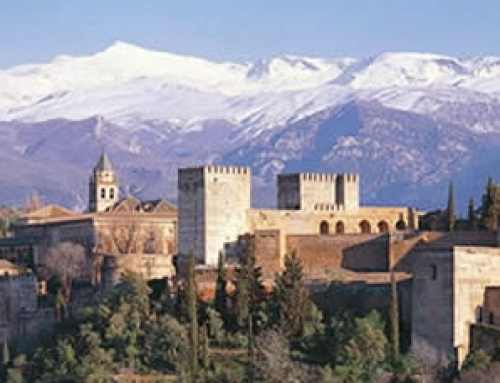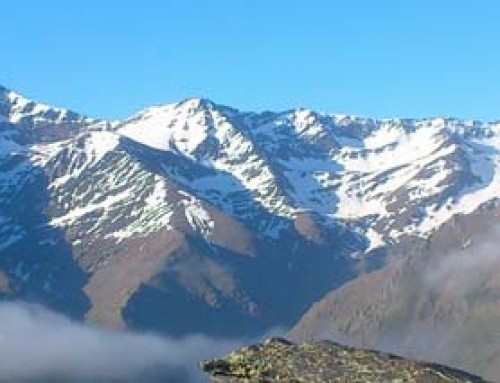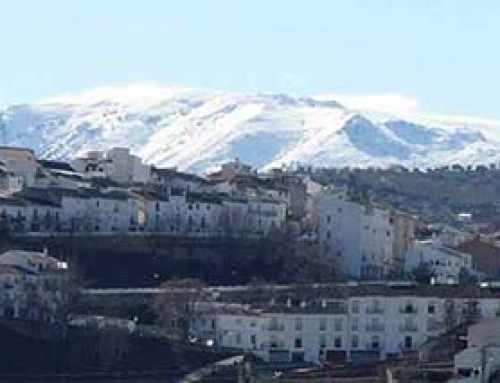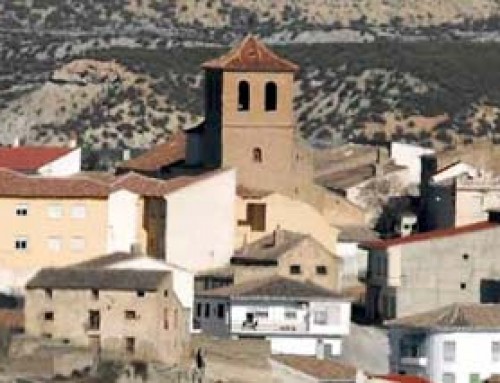Glorious head perched Nazari, this artistic and historic city saw Boabdil mourn for “not having defended like a man”.
History
A primitive core of Iberian settlers settled in the hills where today the suburb of Albaicin and the Alhambra rise. The war between Carthaginians and Romans ended with the victory of the second, prompting a change of course and a revolution in the way of life of its inhabitants.
Granada played a prominent role in the Christianization of the Iberian Peninsula, as evidenced by the fact that uphold the first council of the Spanish Church around 300 A.D. Later, the Roman empire went into decline and Visigoths soon conquer the village and turn it into a military fortress of the first order at the time.
Muslims established at first Garnatha Alyejud settlement, on the other bank of the river Darro. Over time, the Arab influence was imposed to the extent that both cities coexisted until only distinguished one. In the bustle of the Taifa kingdoms, the Nazari dynasty seized power in 1238 to found a new, splendid and modern city, which has almost reached today. In 1492, Boabdil surrendered the square to the Catholic Monarchs with the condition that the Arab customs and religion were respected. However, the real promise cracked soon to raise the Arab inhabitants unbearable economic conditions. As a result of the violation of the agreements of capitulation, the Moors led the revolt of the Alpujarras in 1568. Felipe II need the help of his brother John of Austria, who managed to quell the insurrection definitively in 1571, then drive out the inhabitants Muslims in the city. Although some Moriscos conserved their economic status and their business permits, the collapse of the silk industry in the eighteenth century did disappear from the area to all Muslims.
After the War of Independence, during which Granada was occupied by Napoleon’s forces, the French tastes resulted in modern treatments for parks, squares and gardens. During the century it was marked by clashes between liberal and absolutist tendencies. Then in the twentieth century, the Civil War would break loose.
Once the war ended, Granada profitable knew the monumental legacy splashing all his appearance and attract tourists to its streets.
Gastronomy
Granada’s cuisine has inherited the culinary knowledge of the different cultures that have shaped its history. Arab and Jewish contributions are combined to result themselves, elegant and often imaginative dishes. According hunger and time are available, one can choose between a fried potatoes, migas, tortilla Sacromonte, a saladillas with beans or cod soaking Granada and orange.
In addition to well-known, traditional beans with ham, it is typical potpourri of Jewish origin, and the pot of San Antón, eaten according to the usual- on 17 January.
The bakery also offers a variety of dishes like curd carnival, the soplillos of the Alpujarra Motil real cake. High energy value are the bizcochada of Zafra, fritters of the Incarnation or the pastry of San Jeronimo. Also, piononos of Santa Fe or sweets nuns of Santiago and Santa Isabel have earned a reputation deserved local cuisine.
Parties
The Granada festivities calendar opens on 2 January with the Feast of the Reconquista, in which the banner of the Catholic Kings parades and official functions is present. On February 1 it takes place the procession of San Cecilio Abbey, which concludes with a picnic and dance.
Easter, of great seriousness and rigor, begins with the rise of the Christ of the Gypsies to the Abbey of Sacromonte to end with the departure of Santa Maria de la Alhambra by the “Gate of Justice”.
Cross Day, which is celebrated on May 3, it is tradition that the streets with crosses and floral motifs adorn. At the end of the month you exit procession on the feast of Corpus Christi, and in June, the International Festival of Music and Dance attracts thousands of people to suggestive scenes like the palace of Charles V, the Arab Palace and Gardens Generalife.
visits
Despite being a large city, it is very easy for the traveler arriving in Granada oriented as their most characteristic elements are visible from any part of the city. Getting around her car is a very complicated mission because the city is full of one-way streets and little signage. Therefore, a good way to visit this beautiful city is enjoy hiking and discover, with the classic “slowly but surely”, its most surprising places.
The Alhambra
To start any visit to the city of Granada is a good choice approach this as representative symbol. The Alhambra in Granada is one of the most impressive monuments in Spain. Although it has not been declared as one of the New Wonders of the World in a recent popular choice, the fact is that the great charm that houses attracts countless tourists. The monumental site of the Alhambra is situated on top of a hill, which can be accessed on foot during a walk of about 25 minutes, or with some of the buses leaving the city center.
Currently, the castle or “red fortress” according to the meaning of its Arabic name, because of the color of clay and its striking lighting nocturna- is an extraordinary non-religious Muslim construction. It is a walled complex built between 1238 and 1391, whose main virtue is the new and original combination of elements and techniques already used previously. Her beauty, through its palaces and gardens, is also perceptible aurally, since the rumor of sources accompanies the visitor throughout the walk around the grounds. It is also a Moorish palace built in the Middle Ages and that still stands, since Christians were captivated by her beauty and decided to restore rather than destroy or loot. It houses palaces, baths, a mosque, a fortress and, above all, peaceful gardens that get transported the visitor’s imagination to the time of the Arab domination of this territory.
There are four doors in the wall of the Alhambra, but it is the Gate of Justice which currently welcomes and leading to the citadel, the oldest part of the enclosure. Its main attraction is that it allows a magnificent panorama of the entire city, especially from the tower of Vela. Nazari palaces, occupying the space for the residence of the emirs and strength, are the central part of the visit. Although still retains the architectural unity, this set has been expanded, renovated and remodeled so many times throughout its history which is very difficult to set a date for each of the areas.
Undoubtedly, it stands the palace of Mexuar, which has a portico with nine arches and original wooden eaves cedar that leads to the Mexuar, the courtroom that was used to discuss issues of importance and gives views Albaicin exception. Worth imagine the big occasions and important issues have been addressed within these four walls. Even the spent soil shows the number of people throughout history has walked through this space. Another beautiful room is the Golden Room whose walls are covered with ornaments and decorative items. This also offers extraordinary views of the city.
Nearby is the courtyard of the Myrtles, in which the balance between light water shows the care with which the Arab architects cast all patios. In the living la Barca it features a cedar ceiling oval shape which can recall an inverted boat, so it has been precisely this name.
It is in the Hall of Ambassadors where it is believed that the Sultan Boabdil handed the keys to the city of Granada to the Catholic Monarchs: it was the space devoted to receptions of Arab kings. Noted for its arabesques, stalactites, balconies and incredible tiles.
The best known of the whole area is surely the courtyard of the Lions, belonging to the Royal Palace. Built in 1377, at the time of Mohamed V, it has a rectangular floor guarded by 124 white marble columns of Almeria. Around him, the old Sultan private rooms, of which share four streams that converge in the center, provide the source of the Lions. These twelve beasts dating from the eleventh century are an unforgettable image of the Alhambra. Around this courtyard there are also several rooms open to visitors: the Kings, that of the Mocárabes or of the Two Sisters. From this point you have to cross a nice patio to access the bathrooms, consisting of three rooms: one hot, one cold and intended to rest. In Arab culture, the bathrooms are a fundamental space.
But the monumental complex of the Alhambra still offers visitors other interesting venues. Just opposite it stands majestically the Generalife, a villa with gardens that Muslim kings used as a resting place. The focus is here, in his green and garden areas. In addition to the central pool of whole patio of the Cypresses and the staircase of the Cascades, the patio of the Acequia is a beautiful part of this monumental
You can also visit the palace of Charles V, dating from the sixteenth century and is characterized by its architectural robustness and its circular with two floors of galleries patio. In the interior the octagonal chapel with curious Caryatids, statues of nymphs and satyrs.
Currently, the building houses the Museum of Fine Arts and the Museum of the Alhambra. The former hosts a large and interesting collection of works of art by artists from Granada, especially in the sixteenth century. The Alhambra museum contains stucco, marble, wood and other decorative elements that have been found here.
Finally, before leaving this area, it is worth going to the church of Santa Maria de la Alhambra, just behind the palace of Charles V, built in the seventeenth century on the former royal mosque.
Albaicin and the Sacromonte
On the other bank of the river Darro, which can be crossed by the slope of King Chico, it extends the Albaicín, with its jumbled streets and houses with gardens. This is definitely a neighborhood that houses great charm in this city. His style is reminiscent of a medina; in fact, many Muslims were moved to these streets in the middle of the thirteenth century, after the Christian reconquest of the city of Cordoba. With the arrival in Granada of Christians, the Moors found there his best space. After the killings occurred during the Christmas Eve of 1569, the population dwindled markedly. The last Muslims were expelled in 1609.
Its features steep narrow streets, flowery patios, its beautiful mansions and lively squares offer visitors a perfect picture.
The Albaicín was recognized as a World Heritage Site by Unesco in 1994.
Some of its attractions are Bañuelo street, Paseo de los Tristes, Chapiz the slope, the square of San Salvador and Aliatar, the church of St. Bartholomew, the Long Square and New Street Calderería. An interesting way to see this neighborhood is lost in its streets and gradually discover its many charms.
Above, the Sacromonte is a tour full of color and charm. Of mostly Roma, caves are really troglodyte houses that sink in lhasa slopes and hide flamenco shows, called “zambra”, specially designed for tourists.
Center
Right in the center of Granada, and opening to the Gran Via de Colon, is the cathedral. Its construction began in 1523 under the Gothic criteria imposed Enrique de Eneas, but built the Renaissance style by Diego de Siloam won the set. Highlights its main facade, with its beautiful arches and its main chapel, circular. However, the real jewel of the cathedral is the Royal Chapel. Gothic, is protected by a wrought-iron fence. It is specially designed to become the place of worship of the mausoleum with the challenges of the Catholic Monarchs. In addition, welcomed the mortal remains of Juana la Loca and Philip the Fair, her husband. Currently, these remains are not found in their sarcophagi, since apparently Napoleon’s troops looted the chapel and left empty coffins. Just ahead dela royal chapel an entrance to the madrassa is still preserved, the old Arab university, which still has a beautiful courtyard of small dimensions and Moorish style.
Next to the cathedral, nothing better than the Alcaicería. It is an old Arab souk in the Middle Ages was devoted to the sale of fabrics. Today is packed with businesses that offer all kinds of souvenirs for visitors to this city.
Other points of interest are very near the Corral del Carbon; the church of San Juan de Dios, Grenadian Baroque and St. Nicholas; the Old Town Hall and the Collegiate Church of Saints Justo and Pastor.
Other monuments.
Founded in the late sixteenth century by the Sisters of St. Jerome, the monastery that bears his name it is organized around a courtyard with orange trees. Located on the street Rector Lopez Argueta, you can only visit the ground floor and two wonderful cloister galleries. His church, with a mixture of Gothic, Elizabethan and Renaissance styles, houses an altarpiece from the late sixteenth century that has some chapters of Christianity as the Holy Sacrament, the birth of Christ or the Adoration, among others. Worth attending Vespers sung held there.
Opposite the monastery of San Jeronimo, across the street Great Captain, you get to college, built by Charles I in the early sixteenth century.
Above, the viewpoint of Lona Lane observes the monastery of Santa Isabel la Real. Nor should we overlook the Carthusian monastery, renovated in Baroque style from the sixteenth century. Located on top of a hill northwest of the center retains much of the work of painter Sanchez Cotan, who entered the order in the early seventeenth century. In the church of La Cartuja it is also interesting to visit the Tabernacle, a small chapel dedicated to the Holy Sacrament that was built in the eighteenth century, always under the ornate Baroque style. Next to the Renaissance house of the Father Suarez, Casa de los Tiros currently houses the History Museum of Granada.
Surroundings
In addition to the Natural Park of Sierra Nevada, a few kilometers from Granada, the Sierra de Huétor it is. His wealth is based on its wide variety of native plants and its spectacular groves, composed mainly of pines, oaks and maples. Declared Natural Park in 1989, this area is between 1,100 and 1,675 meters above sea level and covers some 12,500 hectares.
It is highly recommended travel the 20 kilometers from Granada Fuente Vaqueros. This town is famous for being the place where the poet Federico Garcia Lorca was born. There you can visit his birthplace, where a video with some passages of his life, also houses photos, letters and manuscripts is projected. Among the most personal documents highlights the correspondence that the poet had with his sister, and with surrealist painter Salvador Dali.
Also worth a getaway picturesque villages of the Alpujarras: Lanjarón, Pampaneira, Bubión, Capileira, Ferreirola, or Busquístar Pórtugos, among others. This area located just over 50 kilometers from the city of Granada but which rises to an altitude of between 1,000 and 1,500 meters above sea level, it suffers a very high thermal oscillation. The landscapes are idyllic and white populations found there enclaved have a particular charm that has attracted artists and also to religious communities. It is ideal for hiking or cycling, to enjoy nature space and of course, gastronomy. The most characteristic dish known as “alpujarreño plate” is made with trout, ham, sausage, potatoes and a fried egg. Another interesting aspect of this area is the unusual architecture with Moroccan influences. The houses are cubic, with flat roofs and huddled rise to each other. In addition, an efficient system of irrigation canals allow water channeling snowmelt. For fans of literature this place also has the added attraction of being the scene of the novel by Gerald Brennan “South of Granada” a very good opportunity to imbibe the prose of the British who lived in the Alpujarras during the 1920s .
ARAB BATHS
Also known as the “Bañuelos” the whole Arab baths was built in the eleventh century to provide a space in which to bathe in peace and enjoy the serenity of this beautiful place.
It has been remarkably renovated, but still retains that Arab atmosphere that transports visitors to distant times. As you enter you have to cross a small flower filled courtyard to access the various vaulted rooms that serve as entrance to the bathrooms. Some of these vaults are star-shaped holes which allow light to reach inside.
Federico Garcia Lorca
This renowned Spanish poet has left an indelible mark on this city, wing came to refer in this way; “A finger on the vine and a sunbeam mark the site of my heart”.
The Andalusian poet and playwright, admired figure in Spanish literature of the twentieth century, lived some of the best moments of his life here. Although born in Fuente Vaqueros, Granada close to town, in 1898, his family would move soon to the capital, where Garcia Lorca began high school. Later he would enter at the University of Granada to begin his law studies, but he also enrolled at the Faculty of Philosophy and Letters. His great passions were already reading, painting and especially poetry. Among his most admired Spanish authors include the romantic nineteenth century and modern writers in Latin America.
He published his first poems with only 20 years. The great influence of the field reflected intensively in all his work. It was also a source of inspiration for him bullfighting and everything related to the gypsy art. Thus, in 1928, he published the Gypsy Ballads, a book that gave her international fame, and a few years later and after his trip to the United States, come to light his work Poet in New York.
His return to Granada in 1936 was marked by the beginning of the Civil War, which unfortunately put an end to the life of the artist. He was arrested for political reasons and shot at the age of 38 years close to his beloved city.
SIERRA NEVADA
A very few kilometers dela city, and on the border with the Alpujarras and the Marquesado del Zenete, is a fascinating peninsular nature area: Sierra Nevada.
The space love the Muslims of Al-Andalus and was named Sierra del Sol in medieval times, has some of the highest peaks of the Peninsula, as the peaks of Veleta and Mulhacén, offering spectacular panoramic views over the Mediterranean more than 3,000 meters. The climate is ideal to enjoy in winter, snow sports and in summer, mild temperatures that have nothing to do with suffering nearby coastal towns or own Andalusian capital.
Although there are some pretty villages with Muslim background in the nearest part of the city like Dílar, Gójar or Ogíjares-, this enclave is especially attractive for those visitors looking to enjoy nature in its purest form.
Thanks to the enormous wealth of flora and fauna, Sierra Nevada was declared a Biosphere Reserve by UNESCO in 1986; Natural Park in 1989, and a decade later, National Park. Specifically highlight the Mulhacén (3,482 meters) and Veleta (3,394 meters) peaks, but other 16 mountains over 3,000 altitude above sea level. So, lovers of the mountains, hiking, trekking, climbing or canyoneering have an amazing deal here.
The ski area.
Sierra Nevada is a paradise for lovers of all kinds of snow sports, because there a major ski resort in southern Europe is found. Its altitude and latitude allow the perfect to enjoy winter sports place with good weather, because it is one of the ski resorts with more days of sunshine a year. downhill skiing, snowboarding, snowmobiling, paragliding, ice skating or sleigh; the options are endless, as this station has about 2,500 hectares of snow 70 tracks with over 76 kilometers and about 350 cannons to ensure snow conditions during less cold years. In addition, fans of these sports also take advantage of the nightlife of the season, which lasts until May its winter season.






